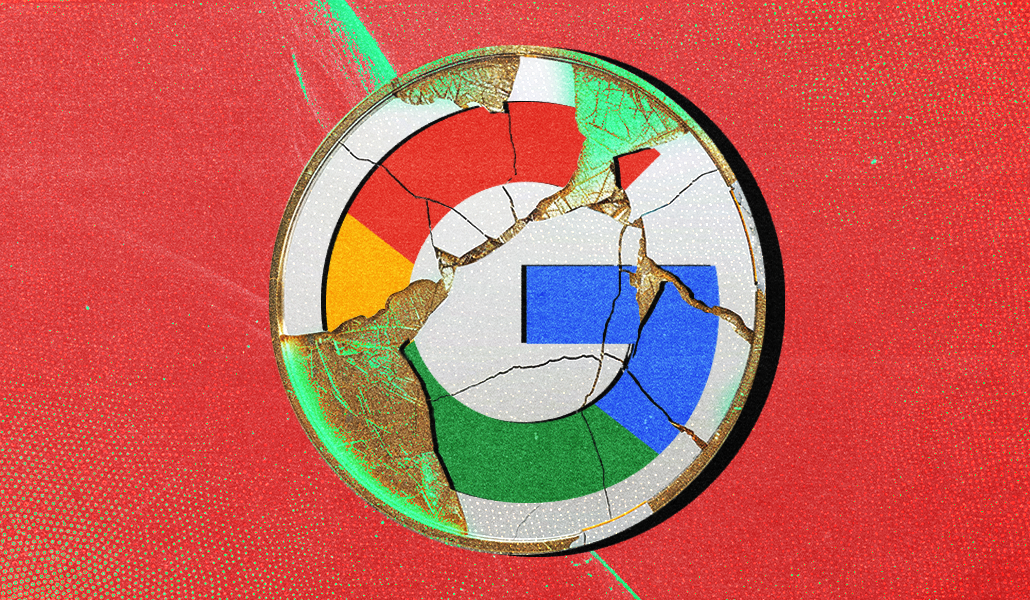“Don’t be evil” might have been Google’s early motto, but it seems like more of a footnote once it went full throttle chasing online ad dollars.
If that sounds dramatic, the third day of its antitrust trial in federal court includes new evidence from U.S. Justice Department witnesses.
Brad Bender, former Google vp of product, answered questions about Google’s succeed-at-all-costs culture — a corporate mindset that fueled the company’s attempt to replicate its search dominance in the display advertising space. As a witness for the Justice Department yesterday, Bender was questioned about emails and chat logs connected to Google’s strategy to gain market share and crush competition during the 2009 recession and in the years that followed.
One email that stood out was from David Rosenblatt, then CEO of DoubleClick, just a year after Google’s $3.1 billion acquisition of the company. The message read: “I really believe that if we can execute on this stuff, we’ll be able to crush the other networks.”
This quote, introduced as evidence by the DOJ, offers a clear glimpse into Google’s aggressive playbook at the time, reinforcing its determination to dominate the ad market.
It turns out, that determination had been building for months.
The DOJ presented further internal communications to support its claim that Google’s acquisition of DoubleClick, along with its popular ad server DoubleClick for Publishers (DFP), was a deliberate attempt to corner the display advertising market through a practice known as ‘tying’.
For those unfamiliar, “tying” is at the core of the antitrust allegations: Google allegedly bundled its publisher and advertiser tools together, securing itself a “privileged position as the middleman.”
Internal emails forwarded between Google execs show some were aware of the situation. The communications indicate that executives knew publishers using DFP would find it a “nightmare to switch” to competitors, effectively forcing them to adopt other DoubleClick products.
Another telling example of Google’s competitive tactics is its approach to header bidding.
Internal emails presented in court discussed how Google developed Exchange Bidding in the mid-2010s, not as a genuine innovation, but as a way to undercut header bidding, which threatened Google’s dominance. One internal email even described Exchange Bidding as “a hack to stem the bleeding” caused by the growing popularity of header bidding — an industry shift that had begun to eat into DoubleClick’s commercial advantages.
A separate 2018 email exchange between Bender and Payam Shodjai — who at the time worked at Google as senior director of Product Management, Display and Video Ads — revealed frustrations with header bidding, despite some Google execs admitting that this alternative to Google’s waterfall advertising system delivered better returns for publishers. “HB [header bidding] gives publishers better yield,” the exchange read, “so it’s a no-brainer for publishers to adopt it.”
The duo also expressed frustration with clients using Google’s demand-side platform, DBM, to purchase ads via header bidding. Highlighting internal tension over Google’s struggle to keep its grip on ad transactions, court docs show Shodjai putting it this way: “The problem isn’t so much that DBM is buying HB inventory — the problem is that HB exists 🙂 [sic]” to the email, which also noted publishers felt locked-in by dynamic allocation in DFP.
Meanwhile, an analysis from DOJ expert witness professor R. Ravi of Carnegie Mellon University shed further light on Google’s secretive initiatives like Jedi Blue and Project Poirot. Ravi, an expert in discrete optimization, provided analysis that found that Google’s 2019 Unified Pricing changes harmed publishers by preventing them from maximizing yield. The shakeup essentially tethered publishers to Google’s tools, such as DFP and AdX. He also noted that advertisers were also harmed by some of Google’s products such as First Look: “The advertiser willing to pay the highest price may not get it as a result,” he said.
Ravi — who also analyzed source code for several products in question — concluded that these maneuvers crippled independent ad tech companies, as bids were funneled toward Google, leaving competitors with far less data and an ever-widening gap in market position. During cross-examination, Google’s lawyer challenged Ravi’s findings and suggested he cherry-picked his analysis. However, Ravi explained his quantitative analysis was based on Google’s own documents and that he analyzed the products with the largest impact on ad auction optimization.
Quote of the day
“It would be the equivalent of Coca-Cola selling their product to a local bodega for 70 cents and to Walmart for $1…It didn’t, and wouldn’t, make sense to us unless there was something else happening.”
The Trade Desk Chief Revenue Officer Jed Dederick gave this analogy while explaining the confusion in the industry when Google first introduced Open Bidding as a response to header bidding.
The last witness on Wednesday, Dederick testified about a range of topics including how TTD competes with Google, the ways header bidding impacts advertisers, publishers and other adtech companies – and how Google’s actions impact various parts of the advertising industry. He also talked about why display ads aren’t the same as other ad formats. He also talked about the conflicts of interest that come with Google operating both an ad exchange (AdX) and a demand-side platform (DSP).
Dederick’s testimony will continue on today when the court resumes cross-examination.
ICYMI
The Rundown: Highlights as sparks begin to fly on Day 2 of the latest Google antitrust trial
And Late in proceedings on the previous day, former Google exec Eisar Lipkovitz discussed his “PTSD” amid a culture that did little to promote diversity of thought on its quest to achieve year-on-year growth (see link above).

